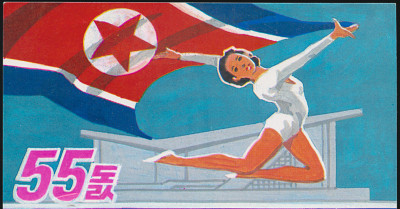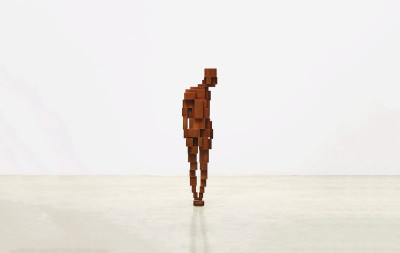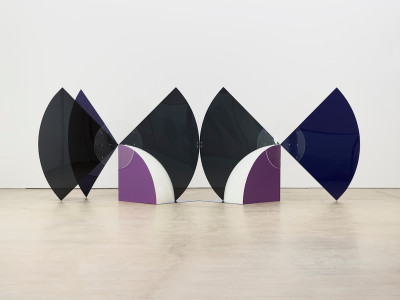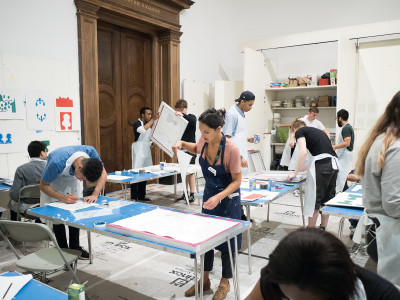10 minutes with… Humphrey Ocean RA
10 minutes with… Humphrey Ocean RA
By Harriet Baker
Published 29 January 2016
The artist tells us why Van Gogh was his earliest inspiration, and why he still loves Josef Albers’ square paintings.
-
Humphrey Ocean RA is a painter, best known for his portraits and chair paintings. His 1984 portrait of the poet Philip Larkin hangs in the National Portrait Gallery, and in 2012 he held a major retrospective there, called A handbook of modern life.
We visited him in his south London studio, where we chatted to the artist about sailing ships, road signs and new music.
What are you working on at the moment?
I’ve been making sculptures for the first time; wooden ships, ferries and cruise liners. They’re inspired by a visit to a cliff top church in Corsica, the Church of Saint Julia. Inside, there’s a wooden boat, a votive offering made by a sailor. It’s not a very big sculpture – it sits on a bit of sea made of painted plaster, held up on a bracket – but I was struck by it. I couldn’t get it out of my head. My father was in the Navy so that may be it. For the last three or four years I’ve been making paintings of a ship because it interested me, and I’ve carried on with it.A ship is a little bit like a studio, and it made me think that being at sea is a bit like being an artist, adrift from many of the things you recognise, from the world as you know it, even from your upbringing – although you never quite escape that. But I like being in a studio on my own, and closing the door on other people, thinking thoughts that don’t conform to anything. It’s a space to experiment.
I suppose I show comparatively rarely and I keep coming back to the portrait.
What’s your earliest memory of art?
I have always painted, I never grew out of it. I remember my mum took me to the Tate Gallery (what is now Tate Britain), when I was 10 or 11. There was an exhibition of the John Hay Whitney Collection and there was a Van Gogh self-portrait. I don’t even know if I had heard of Van Gogh. The portrait had a lapis blue background, and I was just transfixed. I don’t know what it was that got to me, perhaps something of the directness of the painting.Many years later, I talked to mum about this experience, and she said she still had the catalogue. I almost didn’t want to look at the portrait for fear of breaking the spell, but then I did. It wasn’t a fierce portrait, as van Gogh can be. It was quiet, and something about it must have spoken to a 10-year-old. It was almost conspiratorial, as if it were saying, “Come on in, the water’s fine…” But it obviously made me think, “that’s what I’m going to do.”
I still think Van Gogh is top, and I am still trying.
-

Humphrey Ocean RA
-
To be an artist you have to be bold enough to realise your thought is worth thinking.
Humphrey Ocean RA
-
What work of art do you wish you’d created?
I’m very attached to Josef Albers and his squares, especially the ones he painted on what the Americans call masonite and we call hardboard. There’s a kind of precision, and at the same time a roughness to his work. Albers is the missing link of American art; he connects Hopper to Rothko, Warhol to Donald Judd. He taught at the Bauhaus until the 1930s, and his wife Anni made textiles. He only came upon his squares when he was 60, and he just carried on painting them until his death 25 years later.Albers’ squares are mainly about colour, quantity and measure. When I’m making a portrait, I am responding to the person in colour. You don’t need to quiz someone to fall in step with them; a big part of sizing someone up is visual. To me, colour is probably second to children in terms of what is important in the world. People who would say they know nothing about colour will walk out of the door and enjoy a blue sky. It is unavoidable.
-

Humphrey Ocean RA, Tim, 2013.
77 x 56cm. Gouache on paper.
-
How do you know when a piece of work is finished?
When I’m finished with it, or when I become bored, or I’m already onto the next thing. Sometimes I move on from a painting, but sometimes I return to them. There’s a painting in my studio which I showed at the RA in 2005, but since then I’ve returned to it twice, and I think it was really only finished last year. It just needed something. My portraits are finished more quickly. Those I did for A handbook of modern life took less than an hour each, painted with the person there next to me. I don’t touch those again.Where were you when you found out you’d been elected an Academician?
I was at home, and Peter Blake (who I’ve known for a long time) called me. He said: “You can now show six 30-foot paintings in the Summer Exhibition.” Well, he was saying I couldn’t be rejected anymore.Artists are necessarily wary of institutions. I had this idea of what establishments are and what they stand for. But I soon discovered the RA is run by artists, for artists and we can do what we like. For a major art institution this is unusual, oddly enough.
-

Humphrey Ocean RA, Emil, 2015.

Humphrey Ocean RA, Geoffrey, 2010.
-
What does the RA mean to you?
I think it was terrific that Ai Weiwei showed at the RA. His work might have been anywhere else, and it would have been simply an exhibition. Nothing wrong with that. But his choosing to be at the RA was different. We had made him an Honorary Academician when he was incarcerated. He liked that, artists showing him support, and this was his response. That’s what the RA can do.If you were president of the RA for a day, what would you do?
I think the idea of being president for a day is more appealing than being president for any other amount of time, so I would enjoy myself. No time to get bogged down in the job so I may as well take the opportunity to show something like Margaret Calvert’s drawings. She designed our British road signs, the man digging for example. They are some of the great public artworks and we see them every day. I might put those next to a Mondrian and a Stubbs and widen things out a bit.What is your advice to aspiring artists?
To be an artist you have to be bold enough to realise your thought is worth thinking.What music inspires you in the studio?
I prefer new music because it’s about being alive now. More appealing to me in the end than a virtuoso performance of something old hat. I’ve just discovered Spotify and my friend Nick Hornby makes me a playlist every six months with new music. I get absurdly excited when the new crop comes in. Nick introduced me to Sleep All Summer by The National featuring St. Vincent, which I’m listening to right at this moment. I then found out that it was written by Crooked Fingers, and I like that version as well. So it goes on.
-

Humphrey Ocean RA, Wall of Sound, 2014.

Humphrey Ocean RA, After Dark, 2011.









